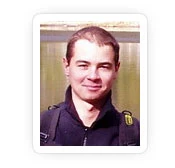How to Lengthen the Hamstrings in Janu Sirsasana

How can you use spinal reflex arcs to facilitate lengthening the muscles in yoga poses? Dr. Ray Long on PNF – Proprioceptive Neuromuscular Facilitation.
Sports medicine experts long ago perceived that this particular reflex arc could be carefully manipulated to lengthen muscles. Using this knowledge, they invented a technique called proprioceptive neuromuscular facilitation (PNF), or facilitated stretching. It is the most powerful method for gaining length in muscles to improve flexibility. Yoga uses stretching, so why not use PNF in our practice to deepen the asanas?
What Are Spinal Cord Reflex Arcs?
Spinal cord reflex arcs are composed of a sensory nerve receptor located at or near the muscle, its connection via a nerve to the spinal cord, an interneuron within the spinal cord, and an afferent nerve back to the muscle. The reflex arc we want to use to gain length involves the Golgi tendon organ. This receptor is located at the muscle-tendon junction and senses changes in muscle tension. The Golgi tendon organ signals the spinal cord when tension increases. The spinal cord then tells the muscle to relax. In essence, this reflex arc creates “slack” to relieve tension at the muscle-tendon junction and helps to prevent the tendon from tearing.
Proprioceptive Neuromuscular Facilitation (PNF) in Yoga
Sports medicine experts discovered that this particular reflex arc could be carefully manipulated to lengthen muscles using a technique they called proprioceptive neuromuscular facilitation (PNF), or facilitated stretching. It is the most powerful method for gaining length in muscles to improve flexibility. Can we also apply PNF in our practice to deepen the asanas?
It is important to remember that any powerful tool, including yoga itself, is a double-edged sword (like a surgeon’s scalpel). If used carelessly, it can cause injury. This is also true of facilitated stretching. The key to using techniques like this is to apply them slowly and with care. They are like a tincture of medicine, so use less muscular force rather than more.
Facilitated stretching works as follows: after warming up, we take the target muscle into a moderate stretch. This establishes the muscle’s “set length”—a measure in the brain of how far the muscle can lengthen. Stretching a muscle produces tension at the muscle-tendon junction and stimulates the Golgi tendon organs located there. The key to PNF is to then gently contract the same muscle that we are stretching. This combines the biomechanical event of positioning the body into a stretch and the physiological event of intentionally contracting the stretching muscle to amplify the tension at the muscle-tendon junction. The Golgi tendon organs fire more intensively, producing a powerful relaxation response. We then stop contracting the target muscle and “take up the slack” by going deeper into the stretch. The net effect is a new set length.
Apply PNF in Janu Sirsasana (Head of the Knee Pose)
Here we use Janu Sirsasana (Head of the Knee Pose) to demonstrate specific guidelines for using PNF to lengthen the hamstrings. Warm up first with a few sun salutations to prepare your muscles. Then take Janu Sirsasana. Bend the trunk over your straight leg and engage the quadriceps to acclimate the hamstrings for the stretch. Next, bend the knee about 20 degrees. Although this takes some of the stretch out of the hamstrings, and thus some of the tension out of the muscle-tendon junction, bending the knee allows us to generate more force during the contractile phase of facilitated stretching.
Then press the heel of the forward leg into the mat (as if you were trying to bend the knee). This cue causes the hamstrings to contract. Build the pressure gradually and top it off at no more than 20 percent of your maximum strength. Steadily engage the hamstrings for five even breaths, and then gradually release the contraction over a second or two. This will have produced the relaxation response. Now take up the slack by straightening the knee with the quadriceps and gently draw yourself deeper into the pose. Engaging the quadriceps not only straightens the knee, but also amplifies the relaxation response through reciprocal inhibition of the hamstrings. Repeat on the other side.
Go slowly with facilitated stretching. Allow about 48 hours of recovery time before re-applying PNF to any given muscle group.
Reprinted with permission from TheDailyBandha.com
Read the first article in this series from Ray Long, MD – How To Use Your Shoulders To Move into Uttanasana.
Read the second article in this series from Ray Long, MD – Lengthening The Torso in Forward Bends.
 Author, Ray Long MD, FRCSC is a board certified orthopedic surgeon and the founder of Bandha Yoga. Ray graduated from The University of Michigan Medical School with post-graduate training at Cornell University, McGill University, The University of Montreal and Florida Orthopedic Institute. He has studied hatha yoga for over twenty years, training extensively with B.K.S. Iyengar and other leading yoga masters.
Author, Ray Long MD, FRCSC is a board certified orthopedic surgeon and the founder of Bandha Yoga. Ray graduated from The University of Michigan Medical School with post-graduate training at Cornell University, McGill University, The University of Montreal and Florida Orthopedic Institute. He has studied hatha yoga for over twenty years, training extensively with B.K.S. Iyengar and other leading yoga masters.

3d Graphic Designer / Illustrator Chris Macivor has been involved in the field of digital content creation for well over ten years. He is a graduate of Etobicoke School of the Arts, Sheridan College and Seneca College. Chris considers himself to be equally artististic and technical in nature. As such his work has spanned many genres from film and television to videogames and underwater imagery.





